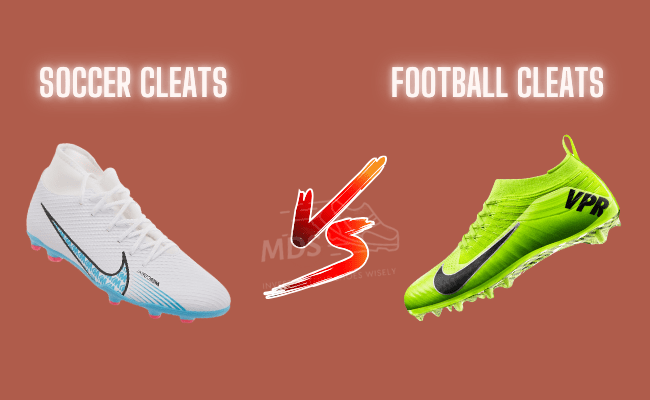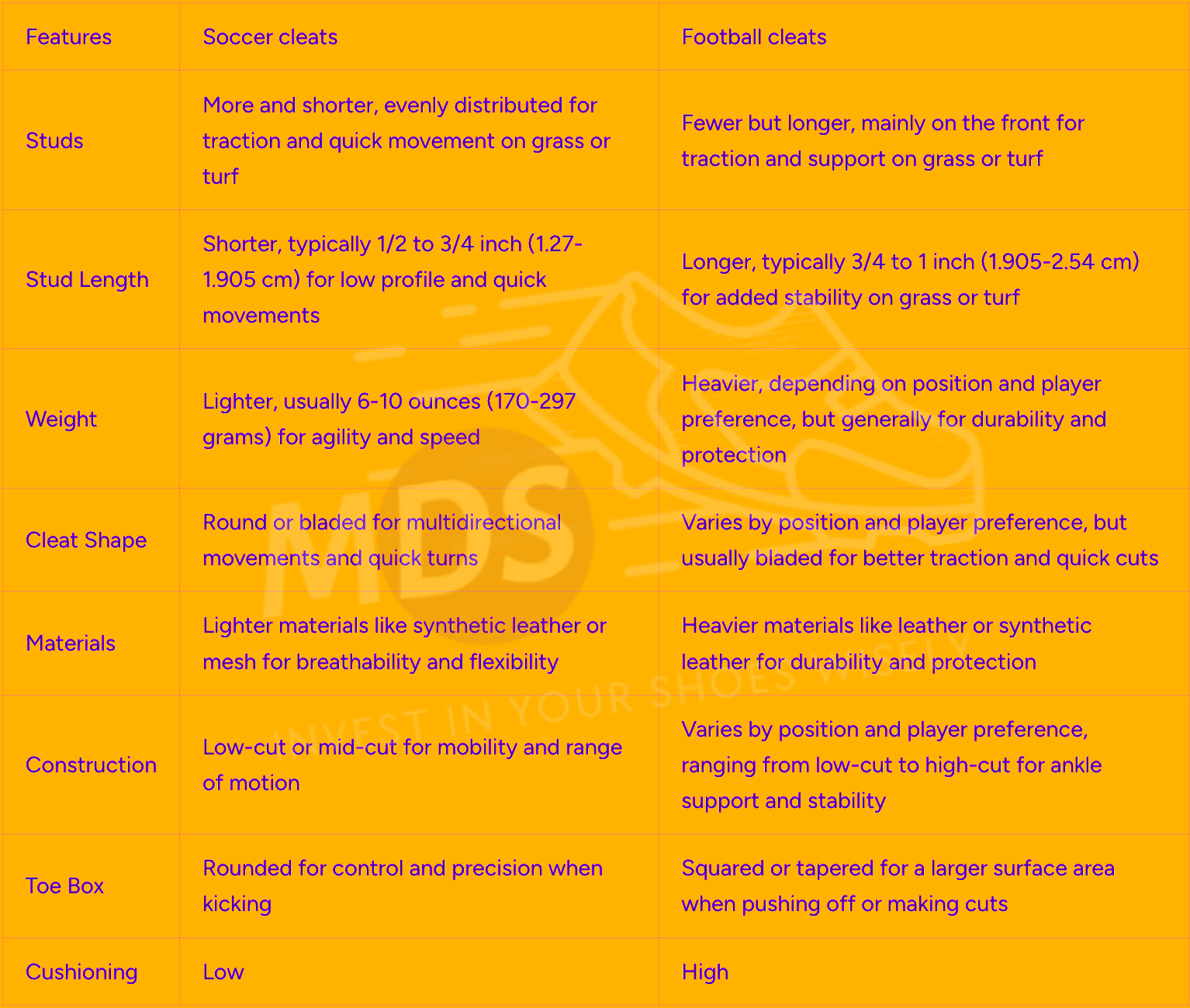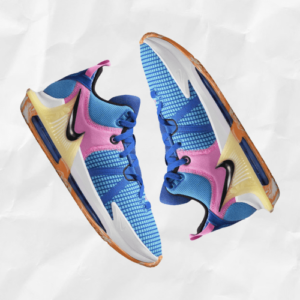Subtotal: $109.00
Difference Between Soccer and Football Cleats: Key Comparisons!

In sports, having the right equipment can make all the difference. The proper cleats are necessary whether you’re running across the soccer field or making a big play on the football field. However, how do you choose which is ideal for you? To assist you in making an informed choice, we’ll help you understand the main difference between soccer and football cleats.
So, let’s start.
What are soccer cleats?
Soccer is a fast-paced sport no matter what position you play, so soccer cleats are designed to be lightweight to enhance players’ agility and speed. Since you’re dribbling, passing, and shooting with your feet, soccer cleats feature durable uppers that help the player have better ball control and touch. The cut of the upper is typically low to allow for plenty of ankle mobility when moving laterally. Finally, soccer cleats feature shorter and many studs to provide plenty of grip and traction while still being safe. They are typically conical or bladed to provide multidirectional traction and stability when changing directions quickly.
What are football cleats?
You’ll notice greater variety when looking for football cleats since you can choose stability or speed depending on your position in the game. The uppers are constructed from sturdy materials like synthetic leather since football demands a lot of physical contact and tackling, which adds stability and support. The upper might have a low, mid, or high top cut, depending on your playing position. Lastly, the outsole’s longer studs provide improved traction and grip on grass and synthetic turf. Usually round or rectangular in shape, they offer a grip for sudden sideways motions or fast runs. A toe spike located close to the big toe is another element of football studs that helps enhance traction during blocking.
What’s the difference between soccer and football cleats?
There are specific variants between football and soccer cleats because each style of cleat is made for the specific sport in mind. The key differences between the two styles of cleats are outlined below:
Soccer vs football cleats chart
Soccer and football cleats hold certain differences. Let’s take a look at how these differ from each other.

And that’s just the brief of it. Let’s look at some of the most crucial differences that set football and soccer cleats apart.
Design
The biggest difference between soccer and football cleats is the design. Since both sports have different requirements, manufacturers design cleats considering these differences.
Soccer cleats
Low cuts on soccer cleats are well-known for giving players greater control over the ball. Since football players move quickly and make rapid twists, they are typically lightweight. They also aid in maintaining players’ speed and agility by supporting the foot’s natural movements. That is not to argue that they are weak. On the other hand, soccer cleats feature hard ground studs that offer a reliable hold on grounds with natural grass.
Football cleats
Contrary to their soccer counterparts, football cleats usually come in high cuts and tend to be heavier to provide foot protection. They offer players various studs to choose from depending on the type of field they’re playing on. Metal cleats work best on natural grass as they provide the necessary traction. However, they’d be too hard on artificial fields, so we recommend using plastic cleats for those.
Materials
Cleats couldn’t serve their function if they weren’t made from proper materials. Let’s see how both cleats’ materials complement their design.
Soccer cleats
Soccer cleats come in a variety of materials, and each one has pros and cons.
- Leather: That’s probably the most famous material for soccer cleats. Thin, comfortable, and lightweight, Kangaroo leather has dominated the soccer market for years. It offers excellent control and helps players maintain manoeuvrability. Its biggest selling point is that it quickly moulds to the feet, making it a versatile option. Unfortunately, it’s not water-resistant. So it’s not the best material to use during winter. While calfskin and full-grain leather tend to be more durable and waterproof, they’re also heavier, so you lose some of that control.
- Knit: Despite being a new addition to the market, knitted cleats have taken the soccer world by storm. You get more control over the ball, almost as if you’re playing barefoot. They’re made from microfibre weaves, which put little pressure on the foot, allowing players to maintain speed and power.
- Synthetic materials: Synthetic materials are more suitable for new players, as they’re light, affordable, and water-resistant. Think of them as the halfway point between leather and knit. They’re thinner than natural leather and maintain a solid grip around the foot, offering better ball handling. They’re flexible and don’t stretch over time. That means you don’t have to buy a new pair now and then.
- Mesh: Like knit, mesh is a new material in soccer. It offers excellent breathability and comfort, helping players reach their optimal speed. However, it’s not durable or waterproof, so it won’t do well in extreme climates.
Football cleats
For the most part, manufacturers make football cleats using the same materials as their soccer counterparts. After all, they also aim to offer players excellent maneuverability while providing a comfortable experience. However, football cleats usually combine several materials to accommodate the aggressive nature of that game.
- The upper side: Like soccer cleats, the upper side of football cleats are made from various materials, the most common of which is leather. While the heaviness of natural leather was a crucial downside in soccer cleats, it’s a big selling point for football cleats. It provides foot protection to prevent injuries from collisions and tackles. A few foot cleats combine leather with textile mesh, the perfect complementary material for leather. It prevents leather cleats from stretching over time. It’s also water-resistant. So you don’t have to worry about ruining your cleats in the rain.
- Heel counter: As the name suggests, the heel counter is at the back of the cleats. It’s usually made from rigid thermoplastic to provide enough support to run, cut, tackle, and drive.
- Toe box: The toe box is the area where the toes sit inside the shoes. It is made of leather or molded plastic and is meant to protect the toes from potential injuries.
Weight
The weight of soccer and football cleats can vary on a number of factors. Here’s a brief look at what those factors are:
Soccer cleats
Soccer cleats are designed to be as lightweight as possible, enabling players to maintain their speed and agility. This lightness allows for better ball control and faster movement on the field.
Football cleats
Football cleats are generally heavier to provide the necessary support and protection. The added weight helps players maintain stability and avoid injuries during high-impact plays.
Sole
The sole of your shoe can largely impact your performance on the field. While the sole on soccer cleats have shorter studs, the studs are a little longer on the football cleats.
Soccer cleats
The soles of soccer cleats feature shorter studs that provide excellent traction without hindering quick movements. These studs are designed to offer multidirectional traction, allowing players to pivot and turn swiftly.
Football cleats
Football cleats come with longer studs that dig into the grass or turf, providing the grip needed for explosive movements and sudden stops. The studs can be rectangular or circular, with an additional toe spike to help linemen gain leverage and stability.
Construction
The construction of cleats is tailored to the demands of each sport.
Soccer cleats
Soccer cleats are designed to be low-profile and flexible, allowing for natural foot movements and quick changes in direction.
Football cleats
Football cleats are built with additional reinforcements and support structures to handle the physicality of the game, including high-impact collisions and sudden directional changes.
Cushioning
Cushioning is another critical factor differentiating soccer and football cleats.
Soccer cleats
Soccer cleats feature minimal cushioning to maintain a close feel with the ball and the ground. This design allows players to have better control and a more precise touch on the ball, essential for dribbling, passing, and shooting.
Football cleats
Football cleats, in contrast, come with significant cushioning to absorb the impact from running, tackling, and sudden changes in direction. This added cushioning helps protect the feet and reduce the risk of injuries, ensuring players can perform their best without discomfort.
Price range and budget considerations
Soccer and football cleats can vary in price. Here’s a look at how they differ.
Soccer cleats
The price range for soccer cleats varies widely based on brand, material, and technological features. High-end models worn by professional players, like the Adidas Predator or Nike Mercurial, can cost upwards of $200. However, many affordable options are available for beginners and casual players, ranging from $50 to $100. Investing in a quality pair of soccer cleats can significantly impact performance and comfort on the field.
Football cleats
Football cleats also span a broad price range. Premium cleats with advanced features and materials can be quite expensive, often exceeding $150. However, there are budget-friendly options available for youth players and those new to the sport. Balancing cost with the necessary features for your position and playing style is important. Quality football cleats can enhance performance and reduce the risk of injury, making them a worthwhile investment.
Versatility and multi-sport use
From design to build and material, every aspect sets both these cleats apart.
Soccer cleats
Soccer cleats are specifically designed for soccer but can sometimes be used for other sports that require agility and speed, such as lacrosse or field hockey. However, their design is optimized for soccer’s unique demands, so using them for other sports might not provide the best performance or protection.
Football cleats
Football cleats are generally less versatile due to their specific design features tailored for football. Their heavier construction and specialized stud configurations make them less suitable for sports that require extensive running and agility, like soccer or rugby. However, they can sometimes be used for other positions in sports that demand similar stability and traction, such as certain roles in lacrosse.
Real-life examples and insights
Now, let’s look at some examples of football and soccer cleats use-cases:
Soccer cleats
- Adidas Predator Freak: Popular among top soccer players like Paul Pogba and David Beckham, the Adidas Predator Freak is known for its innovative design that enhances ball control and swerve. The cleats feature a unique Demonskin rubber spike layer for better grip on the ball, providing players with superior control and accuracy.
- Nike Mercurial Vapor: The Nike Mercurial Vapor, worn by Neymar Jr. and Cristiano Ronaldo, is praised for its speed-oriented features and lightweight construction. To enhance traction and acceleration on the field, the cleats include a Flyknit upper and a specially created soleplate.
Football cleats
- Nike Vapor Untouchable Pro 3: Favored by NFL stars like Odell Beckham Jr., these cleats are designed for speed and agility. They feature a carbon fiber plate for explosive propulsion and a snug, sock-like fit for comfort and support.
- Under Armour Highlight MC: Known for their high-top design and excellent ankle support, these cleats are a favorite among linemen. They offer superior stability and protection, with a lightweight construction that doesn’t sacrifice mobility.
Can you use soccer cleats for football?
While it is technically possible to use soccer cleats for football, it is generally not recommended. The lack of a toe spike and the lighter, more flexible design of soccer cleats can disadvantage football players and increase their risk of injury.
The toe spike on football cleats is crucial for providing the extra traction and push-off power needed for many football-specific movements, such as blocking, tackling, and running with the ball. Players may struggle to generate the necessary force and stability without this feature.
Additionally, soccer cleats’ reduced ankle support and overall lighter weight may not provide enough protection and stability for football’s more physical demands. This could lead to a higher risk of ankle sprains, knee injuries, and other lower-body issues.
That being said, some football players, particularly those in skill positions like wide receivers and kickers, may opt to wear soccer cleats due to their lighter weight and improved agility. However, this is generally the exception rather than the rule, and most football players will be better served by choosing cleats specifically designed for their sport.
Can you use football cleats for soccer?
Using football cleats for soccer is strictly prohibited by the rules of the game. The long, sharp studs on football cleats pose a serious safety hazard to other players and are not allowed on the soccer pitch.
Football cleats’ toe spike and overall stud configuration can easily cause cuts, abrasions, and even more serious injuries to opposing players. This is a major concern in a sport like soccer, where players are constantly in close proximity and physical contact with one another.
Furthermore, football cleats’ heavier weight and bulkier design can significantly impair a player’s agility, ball control, and overall performance on the soccer field. The added weight and lack of flexibility can make it difficult to quickly change direction, dribble the ball, and execute the precise movements required in soccer.
For these reasons, soccer players are strictly prohibited from wearing football cleats during matches and training sessions. Doing so can result in disciplinary action, such as being ejected from the game or even facing suspension.
Factors to consider when choosing between soccer cleats and football cleats
Selecting the right cleats can make a world of difference in your game. Whether you’re sprinting down the soccer field or making a crucial tackle in football, the right footwear can enhance performance and reduce injury risks. Here’s a breakdown of the key factors to consider when choosing between soccer cleats and football cleats:
Playing surface
The playing surface is crucial in determining the type of cleats you need. Soccer and football cleats are designed to provide optimal traction and stability on different surfaces.
Soccer cleats
- Grass or artificial turf: Ideal for firm ground (FG) traction, providing high stability and mobility.
- Soft ground: Screw-in studs (SG) offer better traction on wet and muddy fields.
Football cleats
- Grass: Designed with longer studs to ensure grip and stability on natural grass surfaces.
- Artificial turf: Typically have shorter studs or a turf-specific sole for better performance on synthetic surfaces.
Choosing the right cleats for the surface ensures you stay on your feet and perform your best.
Position and playing style
Your position and playing style are pivotal in selecting the appropriate cleats. Different positions demand various attributes from your footwear.
- Forwards/strikers: Need lightweight and agile cleats to enhance speed and quick movements.
- Midfielders: Versatile all-round cleats for optimal field traction, support, and balance.
- Defenders: Sturdy and protective cleats to withstand tackles and provide stability.
- Goalkeepers: Require grippy and responsive cleats for quick reflexes and sure footing.
Your position dictates the type of cleats that will maximize your performance and minimize the risk of injury.
Fit and comfort
Comfort is king when it comes to choosing cleats. A well-fitted cleat can prevent blisters, improve your game, and keep you comfortable throughout the match.
Fit
- Soccer cleats: Should fit snugly to offer maximum control and agility.
- Football cleats: Need to provide stability and support for sudden changes in direction and intense physical play.
Comfort
- Look for adequate cushioning, padding, and breathable materials to ensure comfort and reduce fatigue.
Traction
- Soccer Cleats: Feature shorter studs for quick grass or synthetic turf movements.
- Football Cleats: Have longer studs for better grip on various surfaces.
Personal preferences
Ultimately, personal preference plays a big role. Some players prioritize comfort over speed, while others might look for the latest technology to give them an edge. Trying on different cleats and understanding how they feel and perform can help you make the best decision.
Insights from coaches and players
Many professional coaches and players emphasize the importance of choosing the right cleats for your sport. According to a study, wearing sport-specific footwear can significantly reduce the risk of lower extremity injuries.
Which cleats should you choose?
What is the conclusion then? It all comes down to the particular rules of the sport you’re participating in. Soccer players require quickness, agility, and accurate ball-control cleats. Soccer cleats’ low-cut style and lightweight construction make them ideal for the fast, agile movements needed on the pitch.
On the other hand, your greatest option when hitting the gridiron is to wear football cleats. They give football’s more muscular and aggressive style the support, defense, and traction it needs. The firm cleats guarantee that you stay planted during those tough plays, and the high-cut shape provides excellent ankle support.
Ultimately, choosing the right cleats isn’t just about comfort but also safety and performance. Wearing sport-specific footwear can significantly reduce the risk of injuries and help you perform at your best. So, next time you’re gearing up for a game, make sure you’re stepping onto the field with the right pair of cleats for your sport. Your feet will thank you!

 NIKE LEBRON WITNESS 7 HYPER ROYAL BLUE
NIKE LEBRON WITNESS 7 HYPER ROYAL BLUE